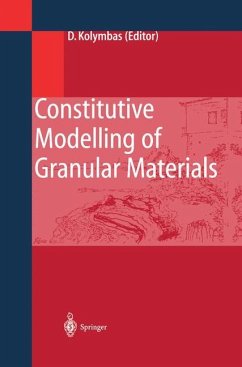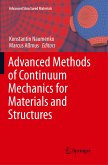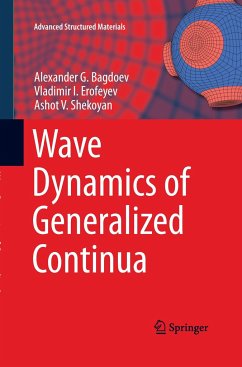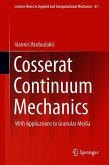Dimitrios Kolymbas
Constitutive Modelling of Granular Materials
Dimitrios Kolymbas
Constitutive Modelling of Granular Materials
- Broschiertes Buch
- Merkliste
- Auf die Merkliste
- Bewerten Bewerten
- Teilen
- Produkt teilen
- Produkterinnerung
- Produkterinnerung
In view of its extreme complexity the mathematical description of the mechanical behaviour of granular materials is an extremely difficult task. Today many different models compete with each other. However, the complexity of the models hinders their comparison, and the potential users are confused and, often, disencouraged. This book is expected to serve as a milestone in the present situation, to evaluate the present methodes, to clear up the situation, to focus and encourage for further research activities.
Andere Kunden interessierten sich auch für
![Predictive Modeling of Dynamic Processes Predictive Modeling of Dynamic Processes]() Predictive Modeling of Dynamic Processes81,99 €
Predictive Modeling of Dynamic Processes81,99 €![Shock Wave Compression of Condensed Matter Shock Wave Compression of Condensed Matter]() Jerry W ForbesShock Wave Compression of Condensed Matter59,99 €
Jerry W ForbesShock Wave Compression of Condensed Matter59,99 €![Mechanics for Materials and Technologies Mechanics for Materials and Technologies]() Mechanics for Materials and Technologies110,99 €
Mechanics for Materials and Technologies110,99 €![Advanced Methods of Continuum Mechanics for Materials and Structures Advanced Methods of Continuum Mechanics for Materials and Structures]() Advanced Methods of Continuum Mechanics for Materials and Structures110,99 €
Advanced Methods of Continuum Mechanics for Materials and Structures110,99 €![Wave Dynamics of Generalized Continua Wave Dynamics of Generalized Continua]() Alexander G. BagdoevWave Dynamics of Generalized Continua74,99 €
Alexander G. BagdoevWave Dynamics of Generalized Continua74,99 €![Cosserat Continuum Mechanics Cosserat Continuum Mechanics]() Vardoulakis (Deceased) IoannisCosserat Continuum Mechanics48,99 €
Vardoulakis (Deceased) IoannisCosserat Continuum Mechanics48,99 €![Fundamentals of Combustion Processes Fundamentals of Combustion Processes]() Sara McAllisterFundamentals of Combustion Processes48,99 €
Sara McAllisterFundamentals of Combustion Processes48,99 €-
-
-
In view of its extreme complexity the mathematical description of the mechanical behaviour of granular materials is an extremely difficult task. Today many different models compete with each other. However, the complexity of the models hinders their comparison, and the potential users are confused and, often, disencouraged. This book is expected to serve as a milestone in the present situation, to evaluate the present methodes, to clear up the situation, to focus and encourage for further research activities.
Produktdetails
- Produktdetails
- Verlag: Springer / Springer Berlin Heidelberg / Springer, Berlin
- Artikelnr. des Verlages: 978-3-642-63115-3
- Softcover reprint of the original 1st ed. 2000
- Seitenzahl: 572
- Erscheinungstermin: 9. November 2012
- Englisch
- Abmessung: 235mm x 155mm x 31mm
- Gewicht: 864g
- ISBN-13: 9783642631153
- ISBN-10: 3642631150
- Artikelnr.: 37478857
- Herstellerkennzeichnung
- Books on Demand GmbH
- In de Tarpen 42
- 22848 Norderstedt
- info@bod.de
- 040 53433511
- Verlag: Springer / Springer Berlin Heidelberg / Springer, Berlin
- Artikelnr. des Verlages: 978-3-642-63115-3
- Softcover reprint of the original 1st ed. 2000
- Seitenzahl: 572
- Erscheinungstermin: 9. November 2012
- Englisch
- Abmessung: 235mm x 155mm x 31mm
- Gewicht: 864g
- ISBN-13: 9783642631153
- ISBN-10: 3642631150
- Artikelnr.: 37478857
- Herstellerkennzeichnung
- Books on Demand GmbH
- In de Tarpen 42
- 22848 Norderstedt
- info@bod.de
- 040 53433511
Professor Dimitrios Kolymbas studierte Bauingenieurwesen an der Universität Karlsruhe, wo er am Institut für Boden- und Felsmechanik promovierte und sich habilitierte. Seit 1994 ist er Professor für Geotechnik und Tunnelbau an der Universität Innsbruck.
Introductory considerations.- The misery of constitutive modelling.- Does engineering need science?.- The role of models in civil engineering.- Overview of hypoplasticity.- Hypoplasticity then and now.- A review of two different approaches to hypoplasticity.- Uniqueness, second order work and bifurcation in hypoplasticity.- Stationary states in hypoplasticity.- Generalized continua and microscopic approach.- Microscopic approach contributions to constitutive modelling..- Discrete and continuum modelling of granular materials.- 2nd Gradient constitutive models.- Micro-mechanically based higher-order continuum models for granular materials.- Relevant local variables for the change of scale in granular materials.- Physical aspects.- On the physical background of soil strength.- The influence of time derivative terras on the mechanical behaviour of loose sands.- An approach to plasticity based on generalised thermodynamics.- Comparison of different approaches.- Comparison of hypoplastic and elastoplastic modelling of undrained triaxial tests on loose sand.- Hypoplastic and elastoplastic modelling - a comparison with test data.- Strain response envelope: a complementary tool for evaluating hypoplastic constitutive equations.- Special models.- Modelling weathering effects on the mechanical behaviour of granite.- A plasticity-based constitutive model for natural soils: a hierarchical approach.- Experimental bases for a new incremental non-linear constitutive relation with 5 parameters.- Numerical applications.- Implicit integration of hypoplastic models.- Soil-water coupling analysis of progressive failure in cuts with a strain softening model.- Advances in modelling soil anisotropy.- Examples of finite element calculations with the hypoplastic law.- Hypoplastic simulationof complex loading paths.
Introductory considerations.- The misery of constitutive modelling.- Does engineering need science?.- The role of models in civil engineering.- Overview of hypoplasticity.- Hypoplasticity then and now.- A review of two different approaches to hypoplasticity.- Uniqueness, second order work and bifurcation in hypoplasticity.- Stationary states in hypoplasticity.- Generalized continua and microscopic approach.- Microscopic approach contributions to constitutive modelling..- Discrete and continuum modelling of granular materials.- 2nd Gradient constitutive models.- Micro-mechanically based higher-order continuum models for granular materials.- Relevant local variables for the change of scale in granular materials.- Physical aspects.- On the physical background of soil strength.- The influence of time derivative terras on the mechanical behaviour of loose sands.- An approach to plasticity based on generalised thermodynamics.- Comparison of different approaches.- Comparison of hypoplastic and elastoplastic modelling of undrained triaxial tests on loose sand.- Hypoplastic and elastoplastic modelling - a comparison with test data.- Strain response envelope: a complementary tool for evaluating hypoplastic constitutive equations.- Special models.- Modelling weathering effects on the mechanical behaviour of granite.- A plasticity-based constitutive model for natural soils: a hierarchical approach.- Experimental bases for a new incremental non-linear constitutive relation with 5 parameters.- Numerical applications.- Implicit integration of hypoplastic models.- Soil-water coupling analysis of progressive failure in cuts with a strain softening model.- Advances in modelling soil anisotropy.- Examples of finite element calculations with the hypoplastic law.- Hypoplastic simulationof complex loading paths.








